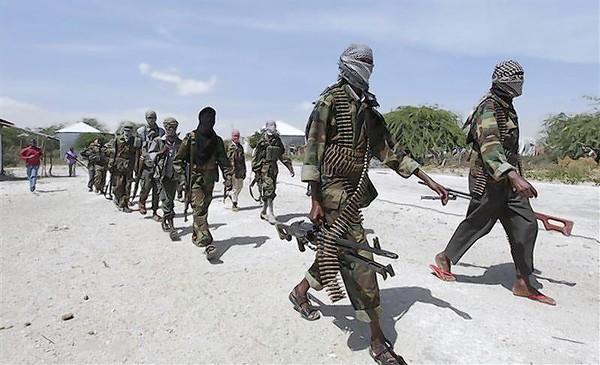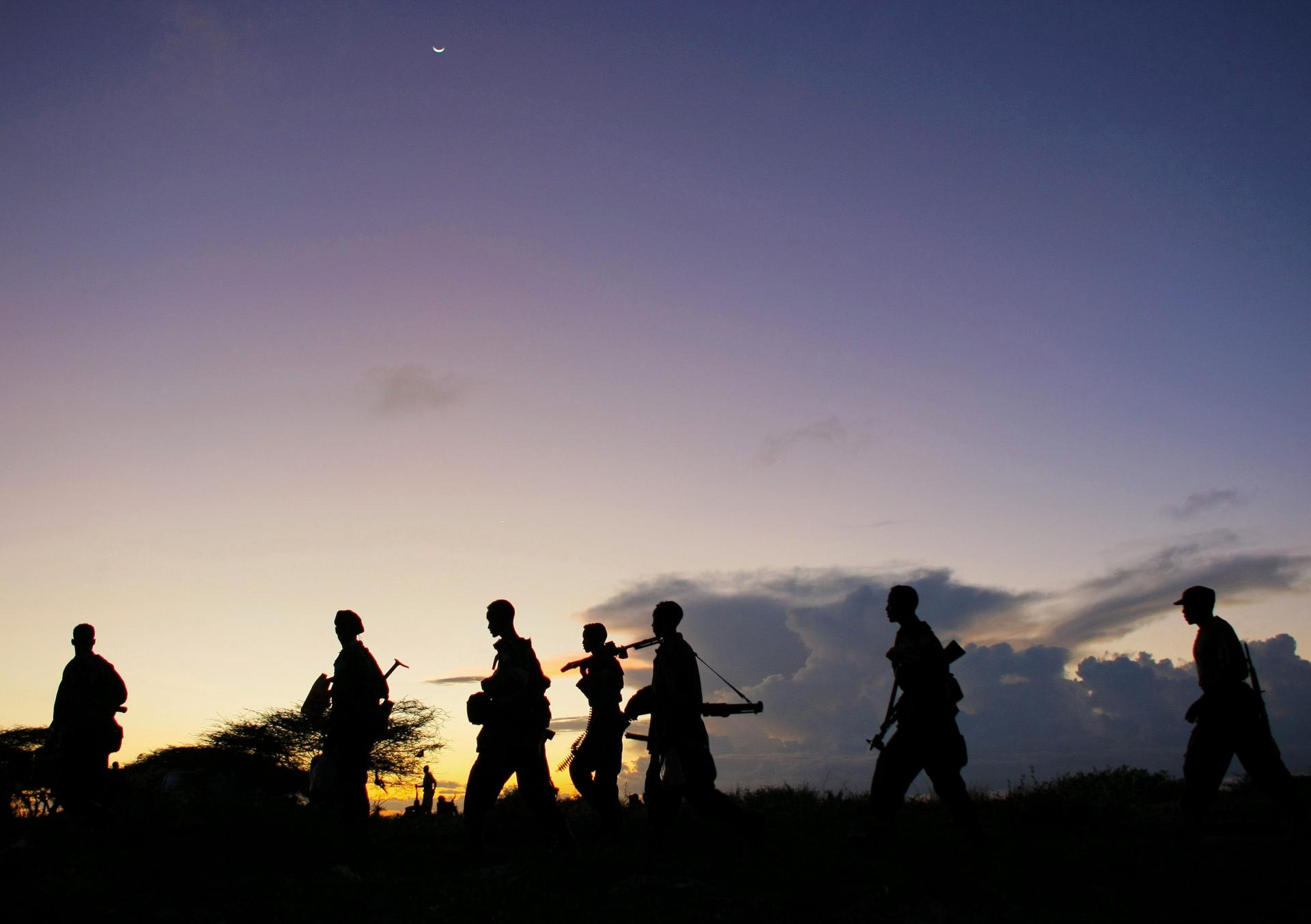Al-Shabaab’s ‘water terrorism’ is yielding results and tragedy in Somalia’s civil war
Somali troops march against Al Shabaab
As Somalia's civil war grinds on in its fifth year, water has become a central component of the war. For the Islamist terrorist group al-Shabaab, that basic necessity is now a critical part of its strategy against the Somali government.
"Al Shabaab has changed tactics and started to cut off liberated cities from their water source so that they can demonstrate some kind of power and presence," says Abdilatif Muse Noor, a member of the Somali parliament.
That shift happened after the Somali government retook most major cities and ports and squeezed al-Shabaab's supply routes. And the new tactic appears to be working. In Garbaharey, a strategically crucial city in southern Somalia, al-Shabaab has managed to destroy the city's water supply without even holding the town.
It's been in the hands of Somali government troops since April 2011. But Abdikhadir, a resident of Garbaharey, describes how “al-Shabaab attacked the city at night and they buried the main borehole that supplied the city with water. In the morning, when we woke up we found the borehole buried, leaving us without enough water for our children, ourselves and our animals.
That forces residents into uncomfortable compromises: "We save the little water we have for our children," Abdikhadir says. 
The Juba River is the other closest water source, but the locals can’t access it because al Shabaab controls the city of Bardheere. About 70 miles to the south, Bardheere is the only place to access the river, and al Shabaab doesn’t allow people from government-controlled areas to come to fetch water.
Noor, the member of parliament, says much of the problem can be traced to a shortage of trained troops. The Somali army is bolstered by AMISOM, the African Union force that has tried over the years to repel terrorist groups like al-Shabaab.
But those troops are limited, and AMISOM has lost about 3,000 men during the war. The Somali army itself remains ineffective.
“We are now starting to train Somali military through AMISOM so that they can be left to safeguard the liberated towns, allowing AMISOM troops to go forward and drive these terrorists out of these cities," Noor says. But that plan, which he vows will happen "in the near future," is yet to be implemented.
Meanwhile, though, the city of Hudur in southwest Somalia is also in dire straits. The locals are upset because, like in Garbaharey, al-Shabaab has successfully used “water terrorism” in the surrounding areas even though the city was liberated by AMISOM and Somali troops in March.
“Since the government forces allied by AMISOM took control of this city, al-Shabaab has deprived us of all access to water,” says Warfa, who lives in Hudur. He says he's stunned that anyone would use water in this way.
“The government and the AMISOM troops have tried to push them out, but they have not managed to do so because the operation is too slow, and because they are facing a fierce resistance from al-Shabaab," he says. "Al-Shabaab doesn’t want to lose control of the water points because then that would mean their full defeat.” 
Government troops and city officials have appealed to international donors for humanitarian air drops, which are now the only source of water. Like Noor, Warfa believes al-Shabaab is using the tactic to "show they are in control and still exist."
Continued conflict, lack of food, climate change, and now water scarcity has taken an enormous social toll. Women have lost their husbands during the clan-based wars, and these same women now grieve over the loss of beloved sons who are often forcibly recruited into al-Shabaab.
Halima, a 45-year-old, handicapped, single mother, lives in War Dararow, a town in central Somalia. Early this year, Somali government and AMISOM troops liberated the town, but al-Shabaab withdrew to the neighboring rural areas and cut off water to Halima’s village. Because the rains did not come this year, she was forced to send her oldest boy to fetch water from the closest well, which was under the control of al-Shabaab.
“I kept on waiting for him but he did not come back," Halima says. "Twenty days later I learned that he was recruited by al-Shabaab. Here, we are desperate. They have occupied all the routes to the city and we cannot get water nor can we get food, and whenever we send out children to get us water … they don’t come back.”
Government officials are promising that the hardship will not last forever. They say their aim is for AMISOM and Somali government forces to push al-Shabaab out of all the major cities and rural areas by the end of 2015, paving the way for a true nationwide election in 2016. But for many Somalis, that's still far too long away.
As Somalia's civil war grinds on in its fifth year, water has become a central component of the war. For the Islamist terrorist group al-Shabaab, that basic necessity is now a critical part of its strategy against the Somali government.
"Al Shabaab has changed tactics and started to cut off liberated cities from their water source so that they can demonstrate some kind of power and presence," says Abdilatif Muse Noor, a member of the Somali parliament.
That shift happened after the Somali government retook most major cities and ports and squeezed al-Shabaab's supply routes. And the new tactic appears to be working. In Garbaharey, a strategically crucial city in southern Somalia, al-Shabaab has managed to destroy the city's water supply without even holding the town.
It's been in the hands of Somali government troops since April 2011. But Abdikhadir, a resident of Garbaharey, describes how “al-Shabaab attacked the city at night and they buried the main borehole that supplied the city with water. In the morning, when we woke up we found the borehole buried, leaving us without enough water for our children, ourselves and our animals.
That forces residents into uncomfortable compromises: "We save the little water we have for our children," Abdikhadir says. 
The Juba River is the other closest water source, but the locals can’t access it because al Shabaab controls the city of Bardheere. About 70 miles to the south, Bardheere is the only place to access the river, and al Shabaab doesn’t allow people from government-controlled areas to come to fetch water.
Noor, the member of parliament, says much of the problem can be traced to a shortage of trained troops. The Somali army is bolstered by AMISOM, the African Union force that has tried over the years to repel terrorist groups like al-Shabaab.
But those troops are limited, and AMISOM has lost about 3,000 men during the war. The Somali army itself remains ineffective.
“We are now starting to train Somali military through AMISOM so that they can be left to safeguard the liberated towns, allowing AMISOM troops to go forward and drive these terrorists out of these cities," Noor says. But that plan, which he vows will happen "in the near future," is yet to be implemented.
Meanwhile, though, the city of Hudur in southwest Somalia is also in dire straits. The locals are upset because, like in Garbaharey, al-Shabaab has successfully used “water terrorism” in the surrounding areas even though the city was liberated by AMISOM and Somali troops in March.
“Since the government forces allied by AMISOM took control of this city, al-Shabaab has deprived us of all access to water,” says Warfa, who lives in Hudur. He says he's stunned that anyone would use water in this way.
“The government and the AMISOM troops have tried to push them out, but they have not managed to do so because the operation is too slow, and because they are facing a fierce resistance from al-Shabaab," he says. "Al-Shabaab doesn’t want to lose control of the water points because then that would mean their full defeat.” 
Government troops and city officials have appealed to international donors for humanitarian air drops, which are now the only source of water. Like Noor, Warfa believes al-Shabaab is using the tactic to "show they are in control and still exist."
Continued conflict, lack of food, climate change, and now water scarcity has taken an enormous social toll. Women have lost their husbands during the clan-based wars, and these same women now grieve over the loss of beloved sons who are often forcibly recruited into al-Shabaab.
Halima, a 45-year-old, handicapped, single mother, lives in War Dararow, a town in central Somalia. Early this year, Somali government and AMISOM troops liberated the town, but al-Shabaab withdrew to the neighboring rural areas and cut off water to Halima’s village. Because the rains did not come this year, she was forced to send her oldest boy to fetch water from the closest well, which was under the control of al-Shabaab.
“I kept on waiting for him but he did not come back," Halima says. "Twenty days later I learned that he was recruited by al-Shabaab. Here, we are desperate. They have occupied all the routes to the city and we cannot get water nor can we get food, and whenever we send out children to get us water … they don’t come back.”
Government officials are promising that the hardship will not last forever. They say their aim is for AMISOM and Somali government forces to push al-Shabaab out of all the major cities and rural areas by the end of 2015, paving the way for a true nationwide election in 2016. But for many Somalis, that's still far too long away.
